| |
|
|
| |
History
2019
|
|
| |
|
|
| |
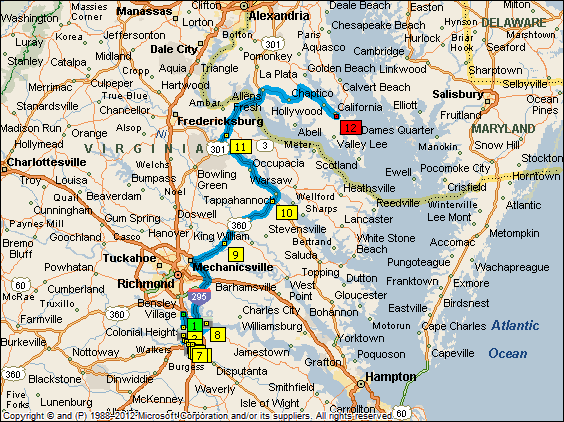 |
|
| |
Breakfast
is a pretty easy decision since there is a Cracker Barrel near by. As I
have said before, when you are not up for a culinary adventure, Cracker
Barrel is pretty much always predictable, reasonably priced, decent quality
and the service is usually good. |
|
| |
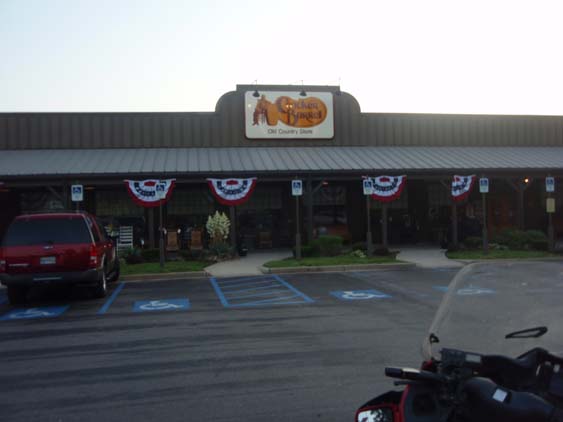 |
|
| |
I get
my required usual dosage of pork and poultry products so I should have enough
grease to keep my aging joints well lubricated. |
|
| |
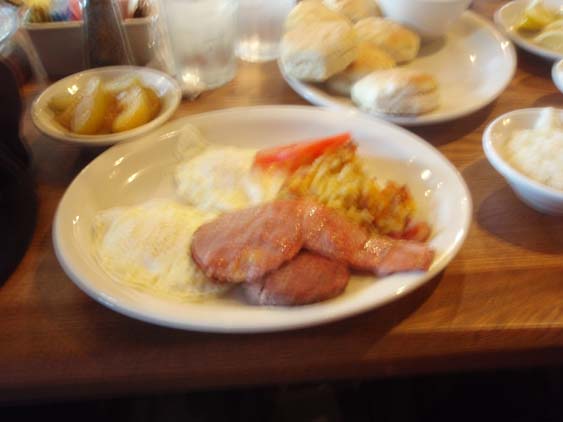 |
|
| |
It's
a short hop over to the Petersburg National Battlefield to see what we can
glean from the museum. After that we are headed for City Point which was
U.S. Grant's headquarters during the siege of Petersburg and the next stop
for JKP as it was also the shipping point for incoming supplies and outgoing
POWs. |
|
| |
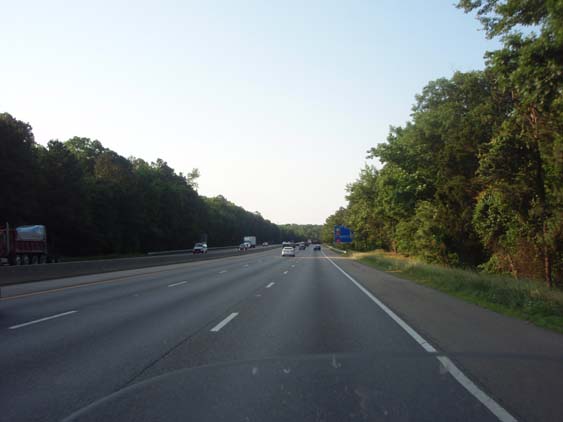 |
|
| |
Soon
we are at the front gate and make our way into the battlefield. |
|
| |
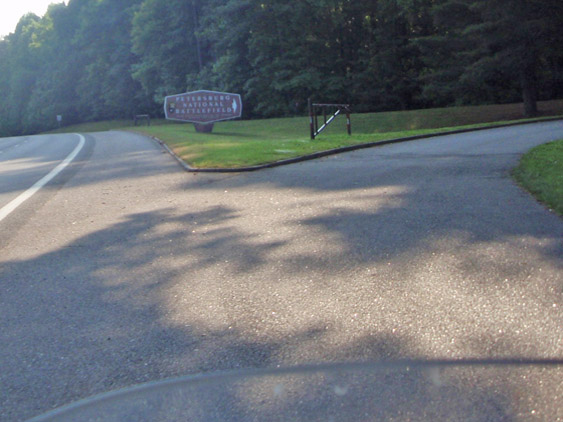 |
|
| |
As it
turns out, much of the battlefield has surrendered to modern encroachment
and the park and museum are surprisingly small considering that this was
a nine month siege during the Civil War. |
|
| |
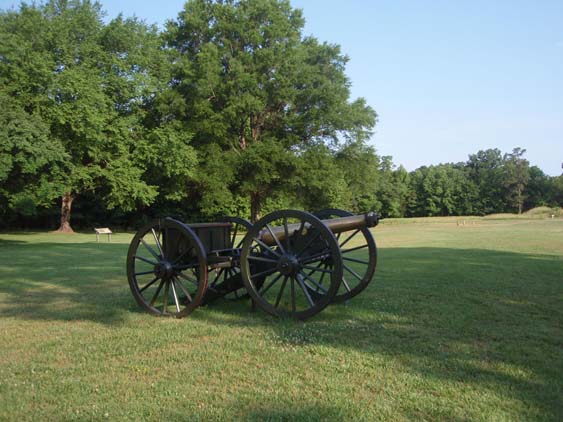 |
|
| |
But one good thing we find
is an explanation why there were no remains of the Shand House on the
hill that I visited yesterday -
The gentle depression
in front of you is the only vestige of the Josiah Jordan House. The house
was dismantled by Union troops during the siege of Petersburg. War came
to the Jordan farm in late 1862, when Confederate engineer Charles Dimmock
laid out ten miles of defenses to protect Petersburg. Battery 5 of the
'Dimmock Line' stood only yards from the Jordan house.
The Shand House, which was
also part of the Dimmock Line, obviously met with the same fate as the
Jordan House.
|
|
| |
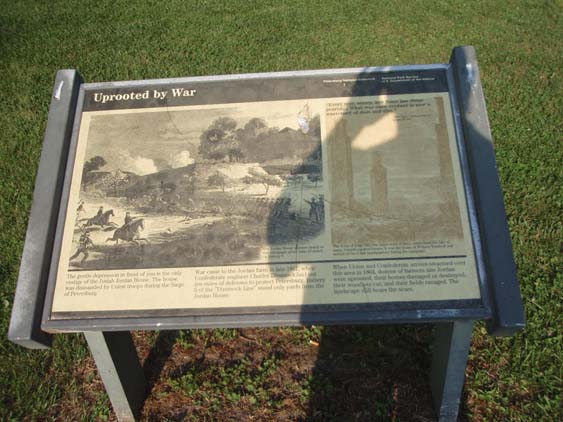 |
|
| |
But it is still hard to image
how such complete demolition and removal could have occurred but the evidence
is before our eyes. In the words of a member of the 17th Maine Infantry
-
"Every tree, stump,
and fence has disappeared ... What was once verdant is now a wasteland
of dust and dirt."
|
|
| |
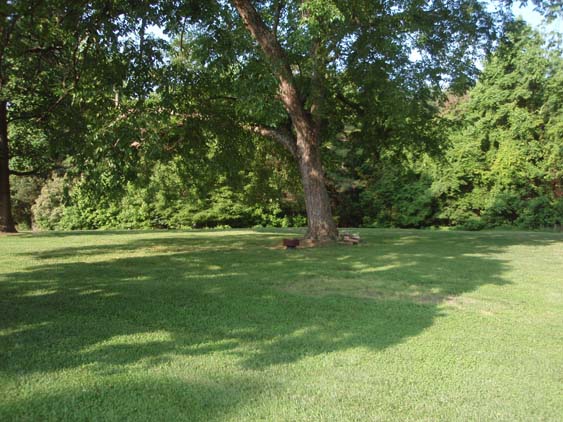 |
|
| |
Along
a walking path they have reconstructed what a Confederate Battery along
the Dimmock Line would have looked like in that day.. |
|
| |
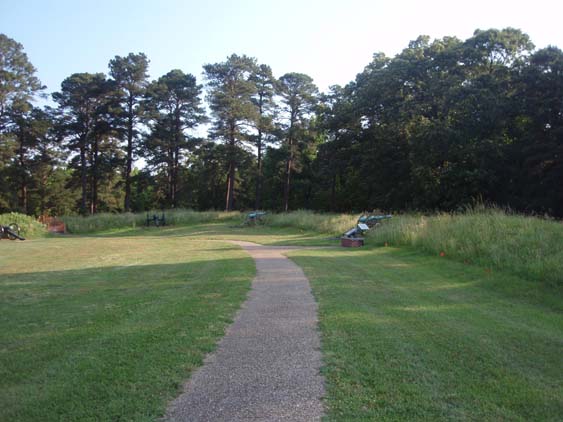 |
|
| |
I see a sign for the 'Dictator'
but they have the path blocked. I tell Sissy and Andy -
"Let me go see if it is
worth the walk before you struggle through this stuff."
It's pretty tough hike around
the construction barriers and then a lengthy hike to the site. The Dictator
was a seacoast siege cannon used by the Union forces during the 1864 siege.
It could hurl a 225 pound explosive shell up to 2 miles but in the end
the military found it to be ineffective for their purposes. To quote a
Confederate soldier inside of Petersburg at the time -
"...the enemy frequently
shoot very large shells into Petersburg, and do some damage to buildings,
but the people are getting used to it, so they don't mind them."
I reckon a feller can get used
to anything over time, but I believe this would a pretty tough 'getting
used to'.
|
|
| |
 |
|
| |
Judging
the size of the cannon and the shells, I'd hate to be one of the fellers
assigned to load this thing with explosive shells that weight over 200 pounds.
And I bet they didn't even wear earplugs when they set the thing off. |
|
| |
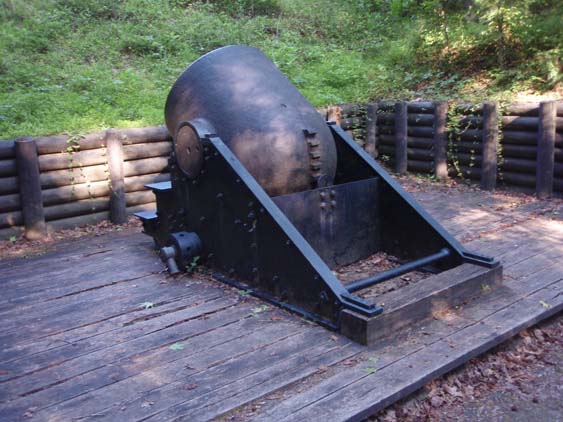 |
|
| |
When I finally get back, I
tell Sissy and Andy -
"You probably don't want
to walk all the way down there through the stuff."
I do show them the pictures
and they are happy enough not to make the long trek.
There's a lot construction
in the park so we make our way carefully to the museum proper.
|
|
| |
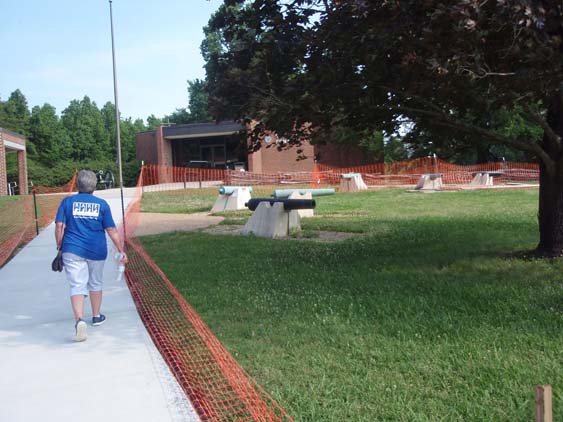 |
|
| |
As I get near the door, a Park
Range is raising of the colors so I stop to watch. When he is finished,
I tell him -
"I was in the Marines
and did color guard on several occasions. We had to deal with the big
Holiday Flag that could lift several of us off the ground if the wind
got up."
|
|
| |
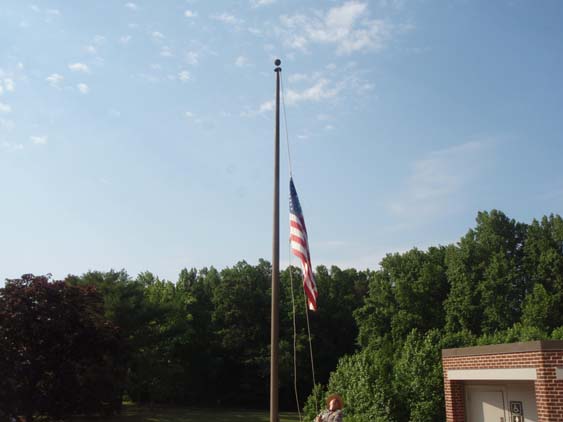 |
|
| |
Inside
the museum is much smaller than I expected. The displays are few but are
well done. This one shows the various ordinance used in the siege of Petersburg. |
|
| |
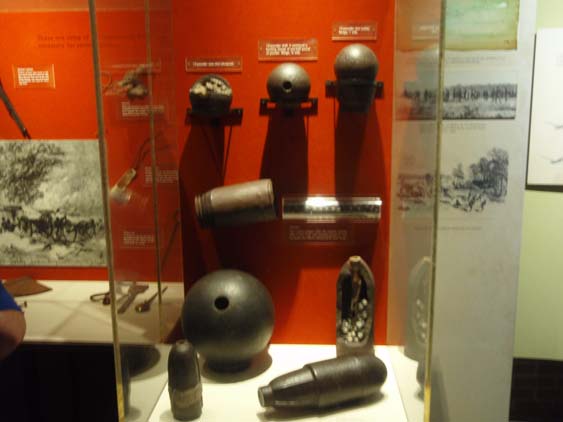 |
|
| |
As I
wander around, I am fascinated this by 'personal' cannon. It's on the order
of the Dictator, but on a much smaller scale. |
|
| |
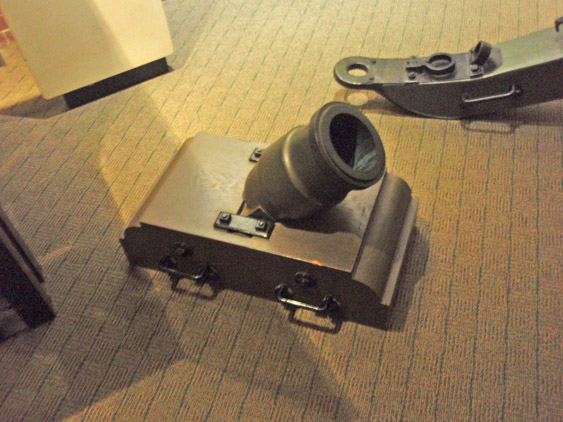 |
|
| |
At little
further along, I see another variation of the same device that the Confederates
used. It is a vivid example of the difference in manufacturing between the
North and the South at that time. This is called an 'Iron Coehorn' - 12
and 24 pound mortars developed specifically for the Confederacy for the
defense of Petersburg and Richmond. They were a simple device that rested
on a plain block of wood for a base. |
|
| |
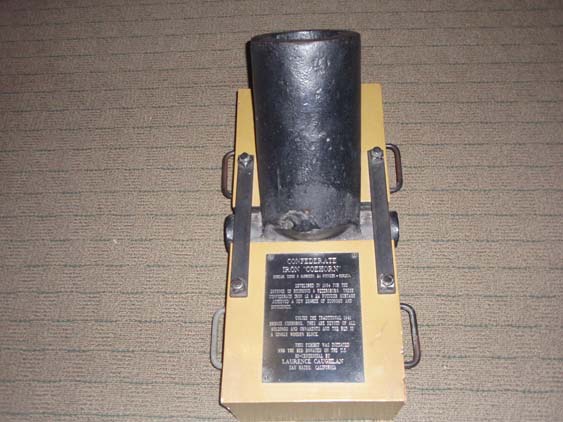 |
|
| |
There
are also several different cannons located throughout the museum. Behind
this one is an actual picture of the Dictator and the crew that manned it. |
|
| |
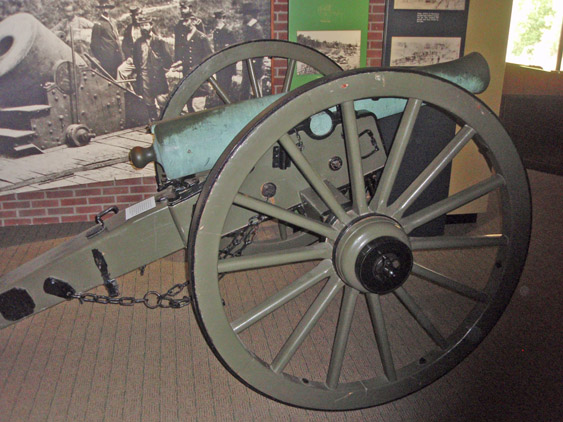 |
|
| |
In another
display case is a grave marker for Confederate soldier that was carved by
his brother. During the war, there just was not enough time for proper burial
of the dead and often the only grave markers were what could be done by
a friend or brother. Many of the bodies were just put into mass graves with
no identification whatsoever. |
|
| |
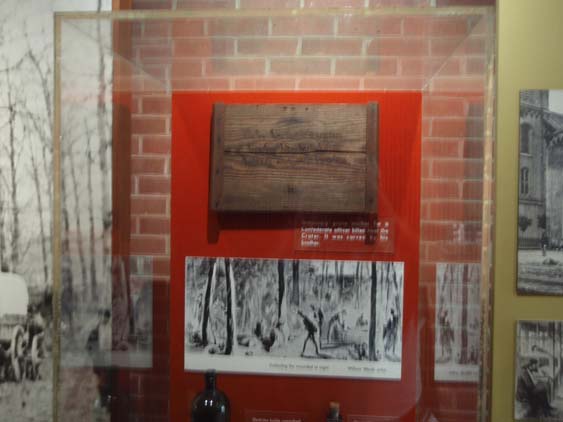 |
|
| |
There's
an interesting display of what a Union soldier had for a mess kit. Most
of these artifacts were recovered from the battlefield after the war. Given
the sad shortages of supplies for the Confederacy, they did not have such
nice equipment. |
|
| |
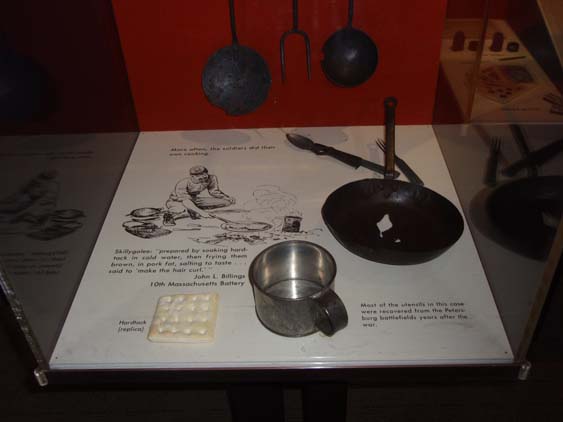 |
|
| |
It is hard to imagine what
it must have been like for a foot soldier to charge a position with one
of these things pointed directly at you. If the cannon ball had your name
on it, your life was over. The ordinance would rip body parts completely
off as it passed by. In the words of Sam Watkins, a Confederate soldier
from Tennessee -
"The firing raged
in front; we could hear the shout of the charge and the clash of battle.
While I was sitting here, a cannon ball came tearing down the works, cutting
a soldier's head off, spattering his brains all over my face and bosom,
and mangling and tearing four or five others to shreds. As a wounded horse
was being led off, a cannon ball struck him, and he was literally
ripped open, falling in the very place I had just moved from."
|
|
| |
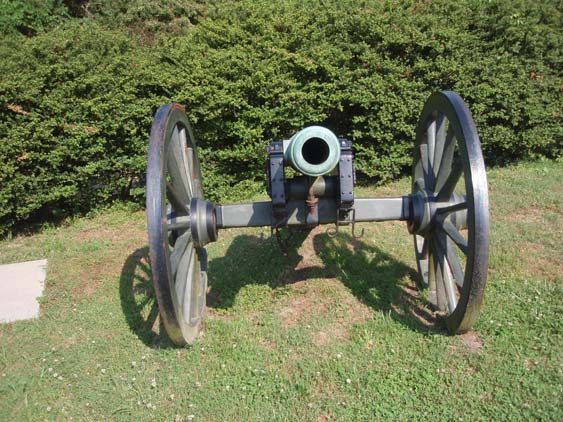 |
|
| |
Next
we head out to City Point which was the major sea port for the Union forces
and where General Grant's headquarters was located. |
|
| |
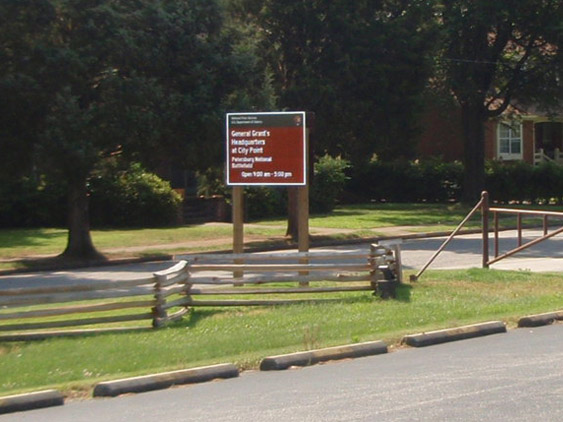 |
|
| |
This
is why we are here as JKP's muster records tell us that he was shipped from
here to Point Lookout POW camp which we will visit next on our journey. |
|
| |
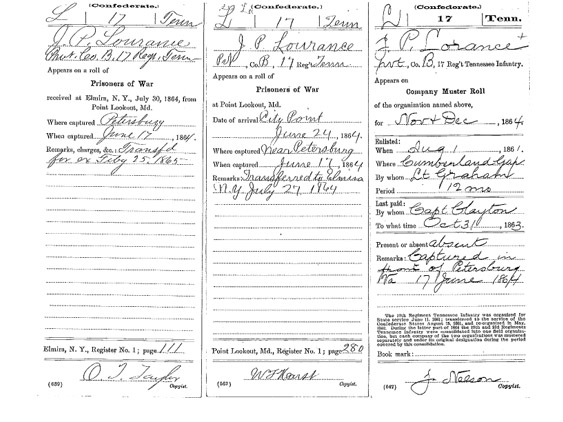 |
|
| |
This
was not only a supply hub for the Union forces during the siege of Petersburg,
but also a shipping point for Confederate prisoners. |
|
| |
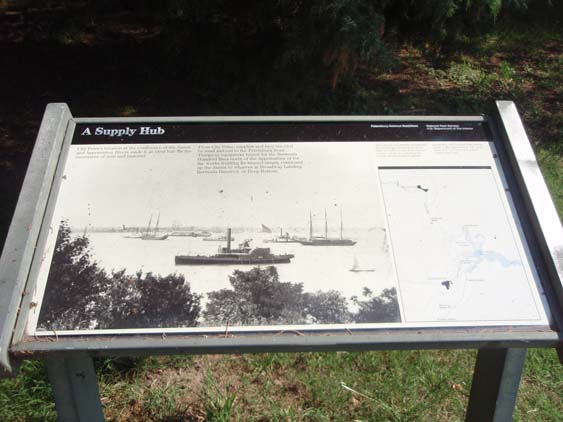 |
|
| |
So we
know that our ancestor passed through this yard at some point during his
short stay here. So Andy again snaps a shot of Sissy and me close to where
he would have been. |
|
| |
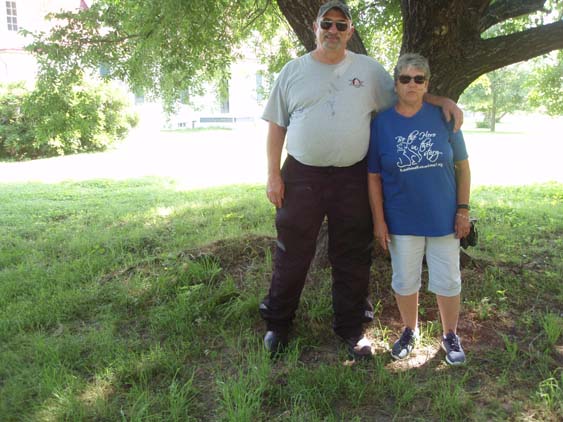 |
|
| |
The
plantation was known as the Appomatox Manor and had been built on a large
tract of land acquired by Captain Francis Eppes in 1635 from the King of
England. By the time of the Civil War it was the center of a plantation
covering more than 2,300 acres with 130 slaves. It was still in the family
at the time of the Civil War, then belonging to Dr.
Richard Eppes. |
|
| |
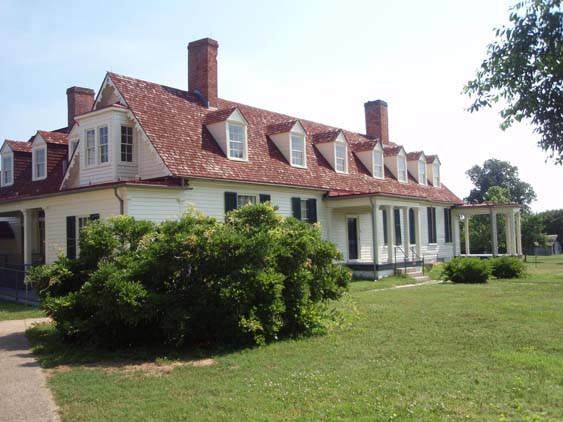 |
|
| |
The Park
Ranger on duty gives us a personal tour of the inside and is very knowledgeable
about the facility. This was the formal parlor where many social events
took place. The Epps were the 'richest of the richest' in this area and
would have entertained the upper crust on most occasions. |
|
| |
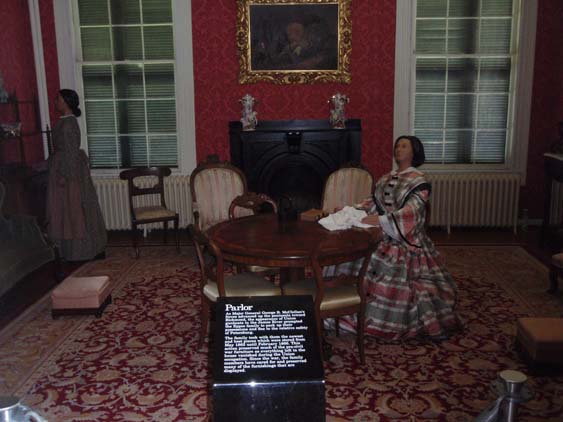 |
|
| |
This
is a view into the library that would have been stocked with all of the
classics in very expensive bindings. Such was the lifestyle in those days
of the very wealthy. However, Appomattox Plantation was used as the offices
of US Quartermaster Rufus Ingalls and his staff during the siege. When Dr.
Eppes returned he found his house in near ruin and his plantation nearly
destroyed. Not until March 1866 with the last Union regiments gone and the
property back in his name did his wife and children return home to pick
up the pieces and start anew. |
|
| |
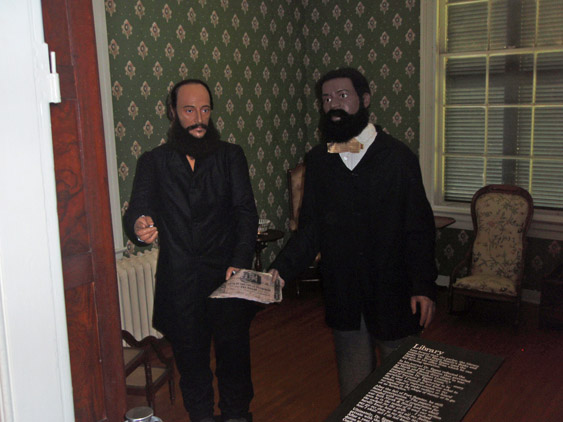 |
|
| |
We see an interesting photo
and device in one of the display cases in the house. Here is the 'rest
of the story' -
On August 9, 1864, a
tremendous explosion shook the city. General Grant reported, "Every
part of the yard used as my headquarters is filled with splinters and
fragments of shell," and a staff officer wrote, "Such a rain
of shot, shell, bullets, pieces of wood, iron bars and bolts, chains and
missiles of every kind was never before witnessed."
Examination of the wreckage
revealed that a barge loaded with ammunition had exploded, detonating
30,000 artillery shells and 75,000 rounds of small arms ammunition. 43
people were killed instantly and 126 were wounded (some accounts put the
death toll at 300). The wharf was almost entirely destroyed and the damage
was put at $2 million.
Confederate Secret Service
agent John Maxwell had smuggled a bomb aboard the ammunition barge. Maxwell
used a clockwork mechanism to ignite 12 pounds of gunpowder packed into
a box marked "candles." He called it his "horological torpedo."
(Horological referring to time keeping; torpedo was a term used in the
Civil War for a wide variety of bombs and booby traps.)
In the case is one of the 'horological
torpedos' that Maxwell did not use and a funny photograph he had made
of himself holding his own head. It was not known until after the war
that Maxwell had actually been responsible. For quite a while everyone
thought it was just caused by improper handling of the ammunition on the
barge.
|
|
| |
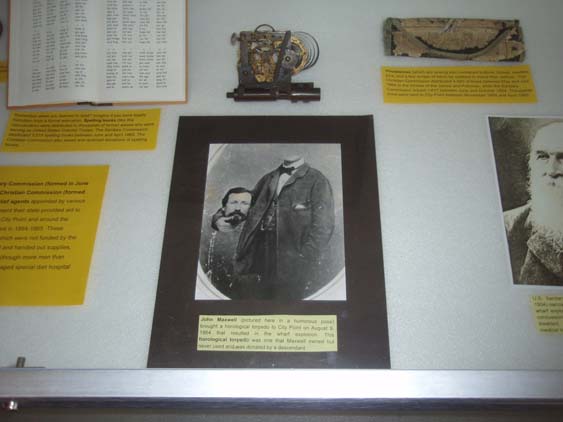 |
|
| |
On the
grounds of the plantation, there is the cabin that Grant used as his headquarters.
What impresses me is that he did not personally take over the more comfortable
plantation house, but chose to stay in the same accommodations that his
officers stayed in. It was said that he had much rather sit around the campfire
with his men than spend time with the dignitaries and men of reputation
of the day. |
|
| |
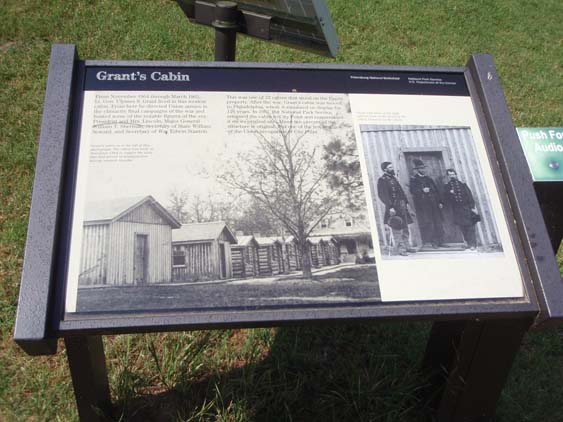 |
|
| |
It is
a simple structure and the only difference from that of his men was he had
an extra room added to accommodate his family. |
|
| |
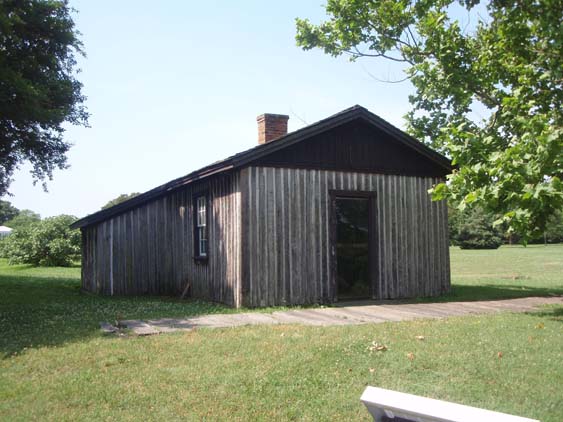 |
|
| |
The ranger
directs us to visit the wharf area, telling us that there is the original
cobblestone road leading down to it. |
|
| |
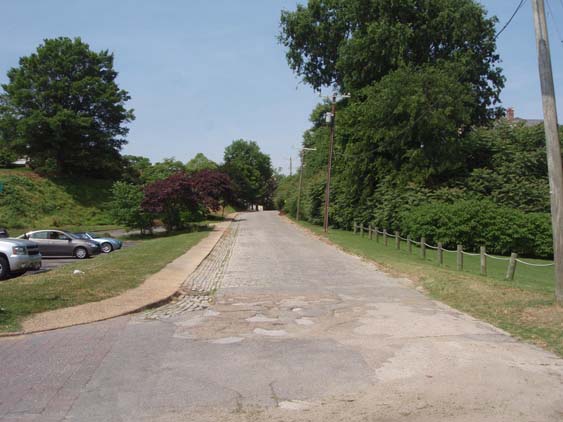 |
|
| |
During
the siege of Petersburg, this was the one of the world's busiest seaports.
From this location, Grant was able to supply over 100,000 troops and 65,000
animals. The horses, mules and cattle consumed over 600 tons of fodder a
day. There were between 150 to 225 vessels loading and unloading on a daily
basis into 8 different wharves constructed here - the largest one occupying
almost 114,000 square feet. |
|
| |
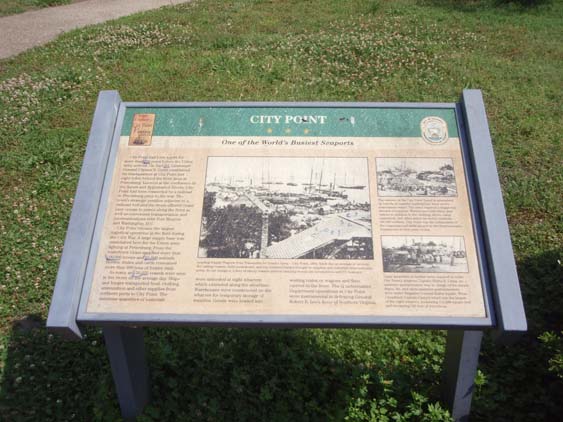 |
|
| |
Since
JKP would have be placed aboard a ship to Point Lookout here, Sissy and
I get our beauty snapped also. |
|
| |
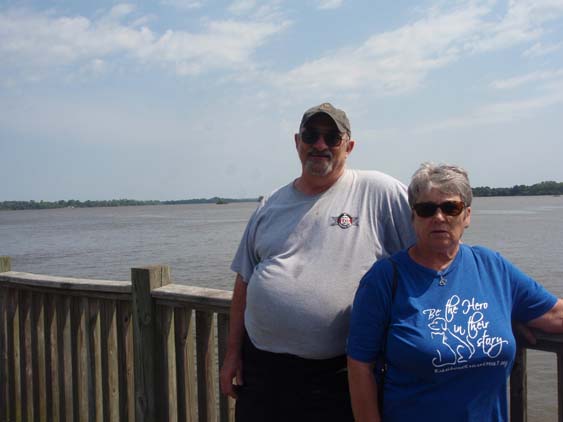 |
|
| |
It would
have been across these waters that JKP would have been shipped to his next
date with destiny. |
|
| |
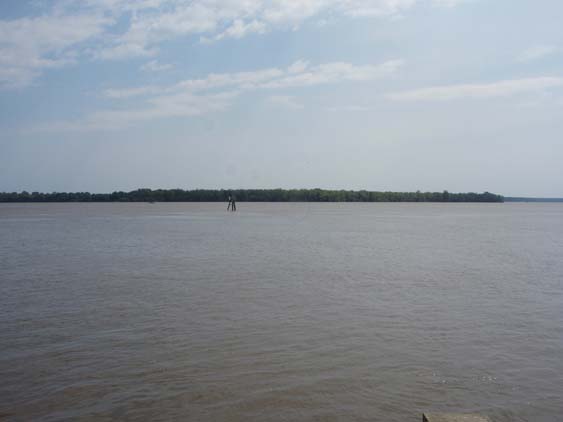 |
|
| |
Next
stop is the Point Lookout POW camp. Our plans are to visit it today if there
is enough daylight left. On the way we cross over this interesting suspension
bridge where the supports are in the middle. |
|
| |
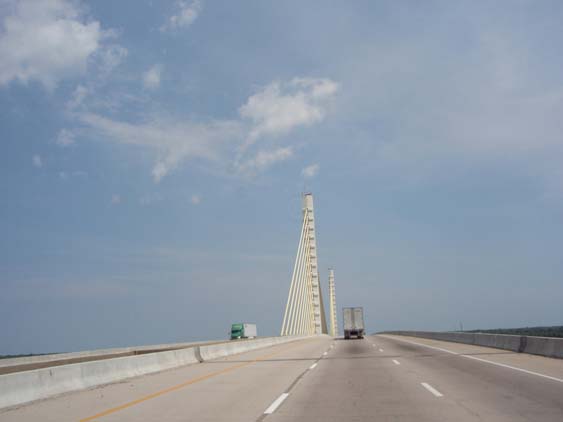 |
|
| |
Traffic
gets a bit crazy on the way over, but by now we are used to dealing with
it. |
|
| |
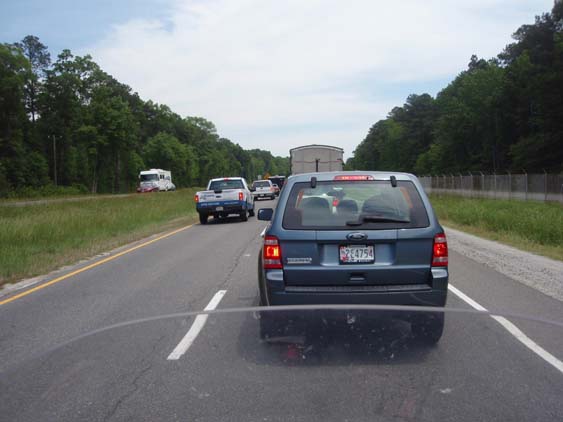 |
|
| |
The problem
is where four lanes have to come down to two lanes to cross long bridges
across the various rivers and bays. Somehow, drivers in the United States
cannot seem to fathom how to do an orderly merge. My suspicion is that it
has a lot to do with mobile phones and a 'me first' attitude. |
|
| |
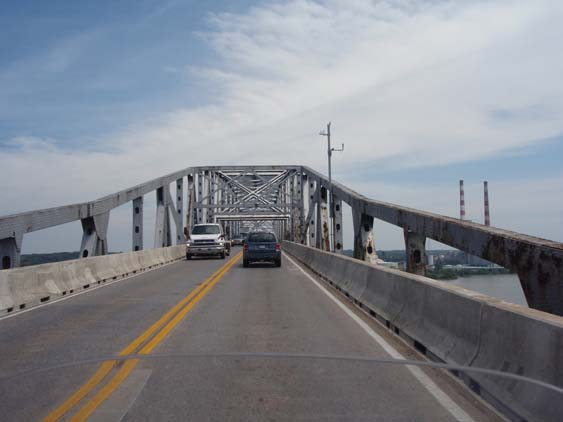 |
|
| |
We find
it a little disappointing that the only reminder in the state park is this
marker. This was one of the largest Union POW camps during the war with
a very high percentage of deaths of the Confederate soldiers incarcerated
there. They only had tents for shelter during the cold winters and disease
was rampant. |
|
| |
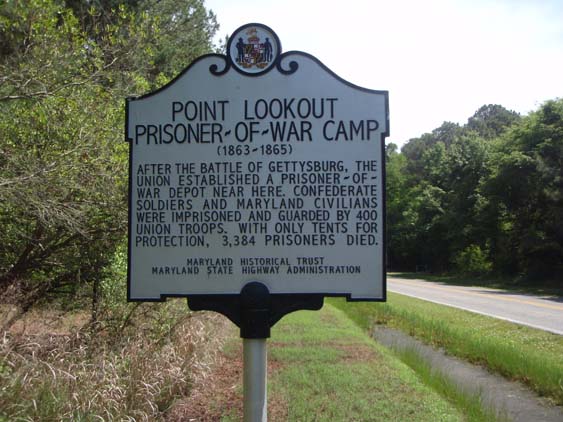 |
|
| |
But
it is what it is so Sissy and I get our beauty snapped here also. |
|
| |
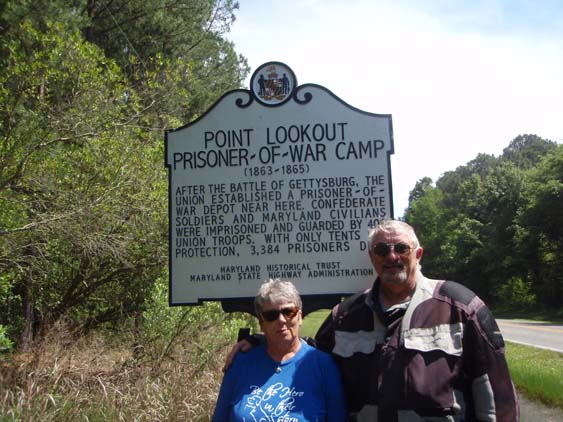 |
|
| |
JKP
would have been interred for the short time he was here somewhere back in
those woods in front of us. |
|
| |
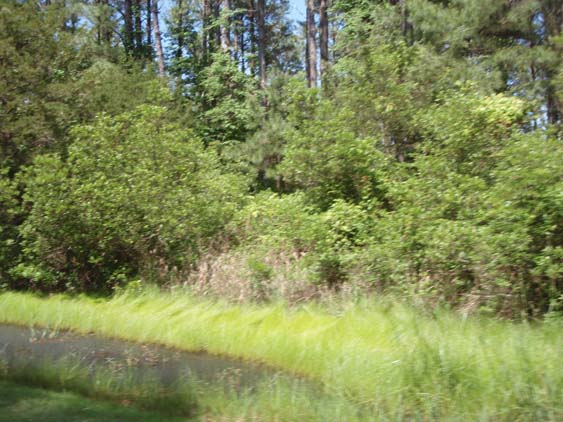 |
|
| |
Further
up the road we see this nice memorial and figure we will pull in and see
what it is all about. |
|
| |
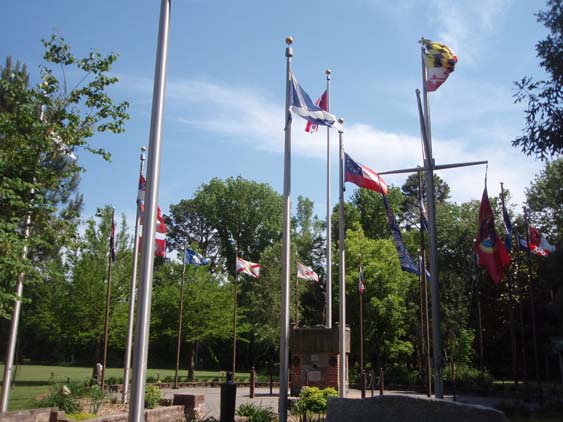 |
|
| |
It turns
out to be a memorial set up by descendants of those men who were imprisoned
at Point Lookout POW camp. |
|
| |
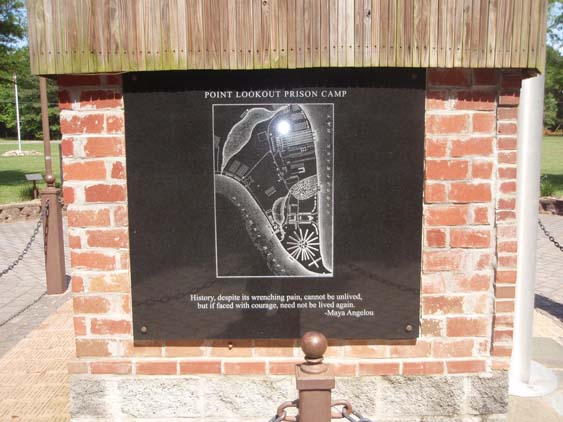 |
|
| |
As we walk around, we see the
sad story why this is a private memorial not on state land. The placard
says -
Point Lookout Prisoner Of War Descendants Organization (PLPOW) was
founded to honor the sacrifices of their ancestors as well as to bring
to the public the true story of the inhumane treatment of prisoners at
Point Lookout.
In 2002, the Maryland State Park Service and the U.S. Veterans Administration
began to require all speeches and reenactments to be submitted for censoring
as well as other discriminatory actions directed at only Southern heritage
organizations. The most unacceptable directive for descendants to accept
was the prohibiting the display of the Confederate Flag over the mass
grave of thousands of men that fought and died under the Confederate banner.
In 2003, PLPOW purchased this land to erect a memorial plaza that would
be free of government interference and restrictions. This memorial will
list the hundreds, perhaps thousands, of additional documented names of
those that died are not list on the monument at the adjacent Federal Cemetery.
It closes with an interesting
quote -
"All that was, or is now, desired is that the truth be told,
without exaggeration and without omissions, truth for its own sake for
the sake of honest history"
Rev. James P Smith, Last Survivor of the Staff of Lt. Gen Thomas J. "Stonewall'
Jackson.
It has been said that those
who do not learn from history are doomed to repeat it and we see that
even today. Regardless of where one lands on all of the discussions about
the Civil War, it is a mistake to try to frame what happened over 150
years ago in the modern framework of political correctness. It is history
and it happened - good and bad. To try to erase it, suppress it, decide
what should be seen and not seen, or to assess it's worth based on what
we think now is a position of the highest level of intellectual dishonesty
that can be held.
|
|
| |
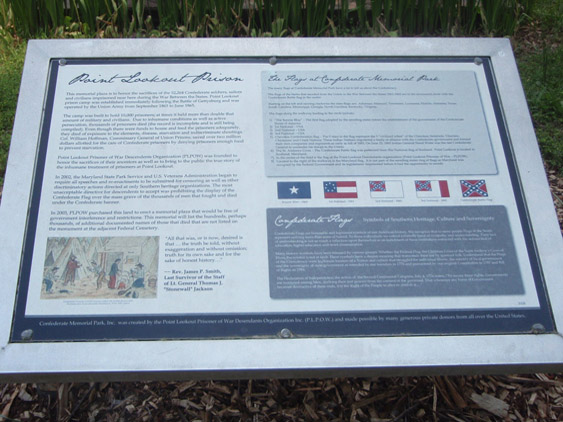 |
|
| |
On a
board in the park, there are the 'faces' of Point Lookout - pictures of
the men who actually were there. |
|
| |
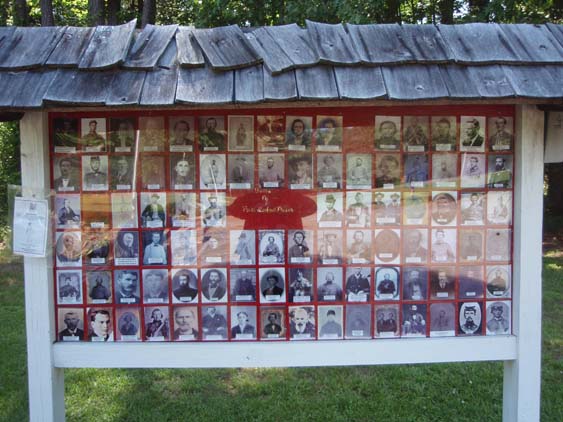 |
|
| |
There are various
flag poles flying flags representative of the states that had prisoners
in the camp. Beneath each flag pole there plaques called 'Voices from the
Pen' where quotes from the prisoners of that state are engraved. |
|
| |
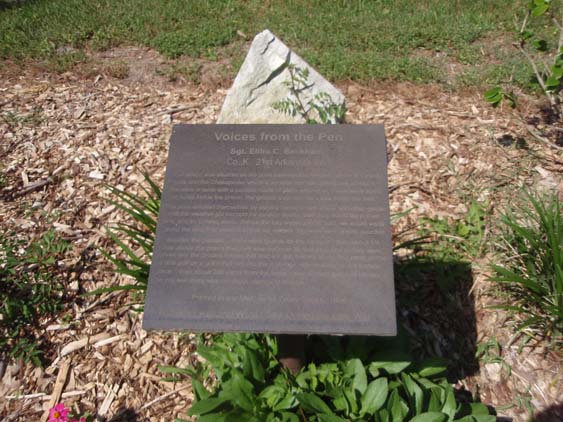 |
|
| |
It was horrible
place where many men died from lack of proper protection from the elements.
Fortunately for JKP, he was only there for a short time before he was shipped
up to the Elmira POW camp in New York state. |
|
| |
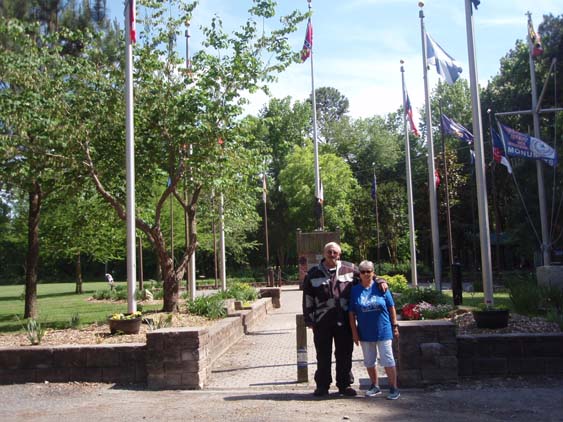 |
|
| |
As we pass by the
Confederate Cemetery next door, we see the 'flag pole of contention' mentioned
in the memorial. |
|
| |
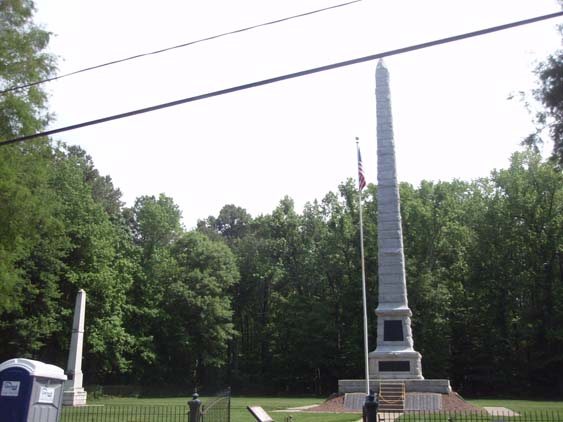 |
|
| |
On the way out,
I see a Dollar General Store and a gas station. I need to pickup some potassium
tablets for recently occurring leg cramps and some Band-Aids for the big
blister on my right toe. After I gas up, I go into the Dollar General and
they have just what I need. |
|
| |
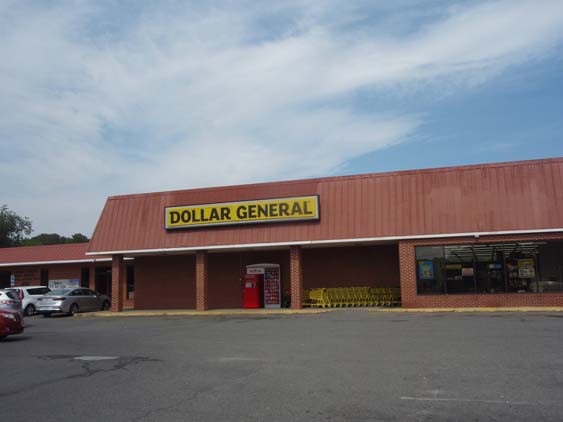 |
|
| |
Our motel rooms
are in California, Maryland and when we get into the town proper, we think
we have landed in the state of California - or at least the state of confusion.
There is a fierce storm headed directly for us and traffic is at standstill.
Andy and I figure we are fixing to get drenched while we sit. It seems like
it takes us forever to move even 100 yards forward. |
|
| |
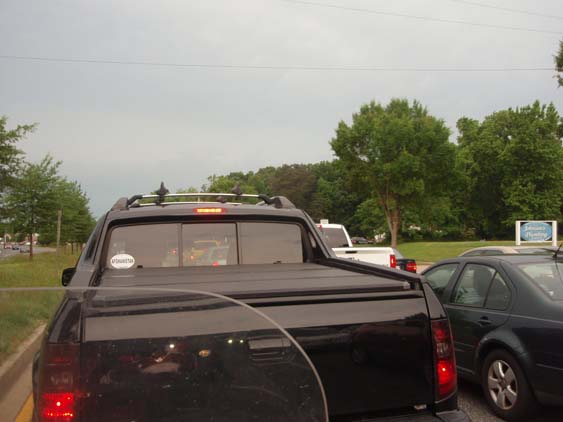 |
|
| |
Finally we see the
sign that we have been seeking and the bottom has not fallen out just yet. |
|
| |
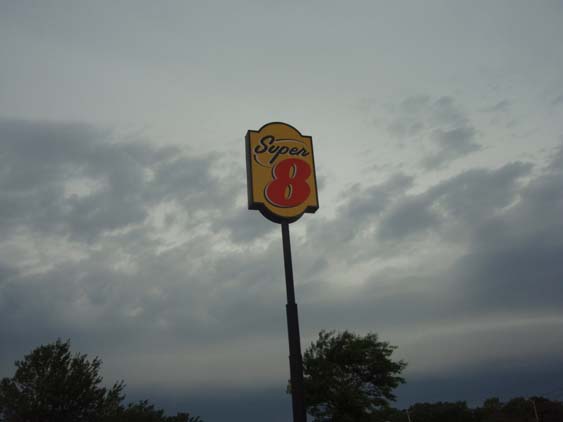 |
|
| |
We quickly get checked
in and get the bikes and Sissy's car covered up just as the storm blows
over. It is raining so hard that it makes little rivers of rain as it hits
the ground. There are some pretty serious wind gusts, but everything stays
in place and for that we are thankful. We figure we will hold up a bit before
we decide what we will do for supper. |
|
| |
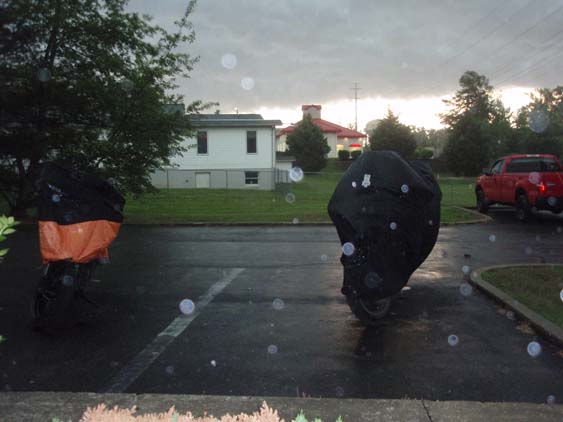 |
|
| |
But after about an hour, the
storm is past and the skies start clear. I ask the motel clerk my usual
question -
"Where do you eat when
you are around here?"
"Oh, there's a good Mexican
place just up the road" he tells us.
"Close enough for us old
folks to walk there?" I ask.
"Yes, just cut across
the foot bridge and you should be good. But don't use me as judge of what's
good" he tell us.
We figure better the devil
he knows than the devil we don't know so we head out for the Plaza Tolteca.
|
|
| |
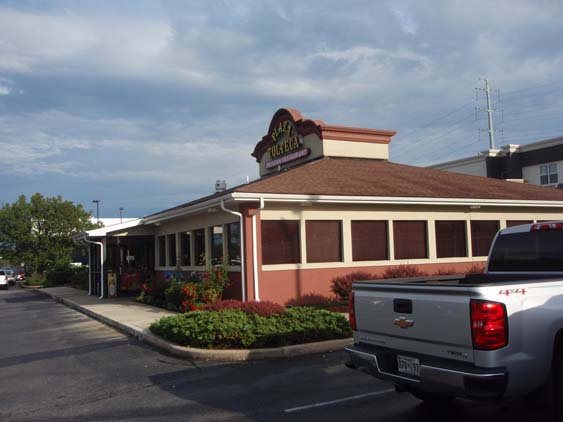 |
|
| |
It is beautifully
decorated inside and if the food is the same quality as the decor, it will
be really good. |
|
| |
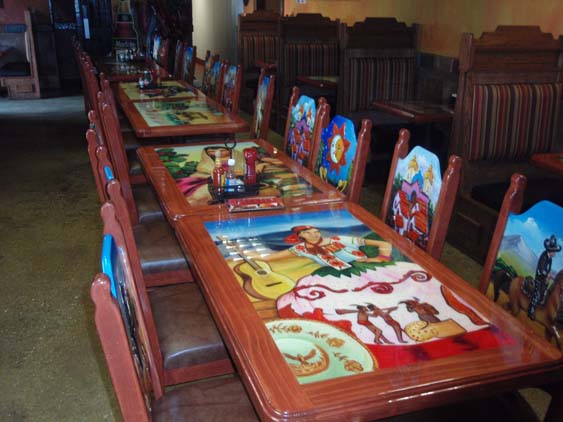 |
|
| |
I order the 'grande'
special and it is indeed 'grande' - comes on two plates because there is
so much food. |
|
| |
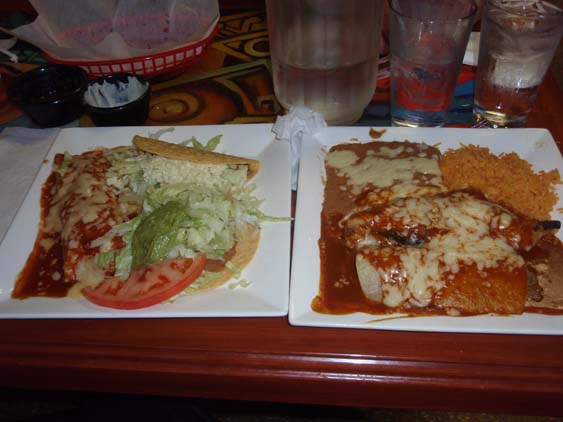 |
|
| |
But I'm the man
for job and sweep the battle field before me as clean as you can get it
without licking the plates. |
|
| |
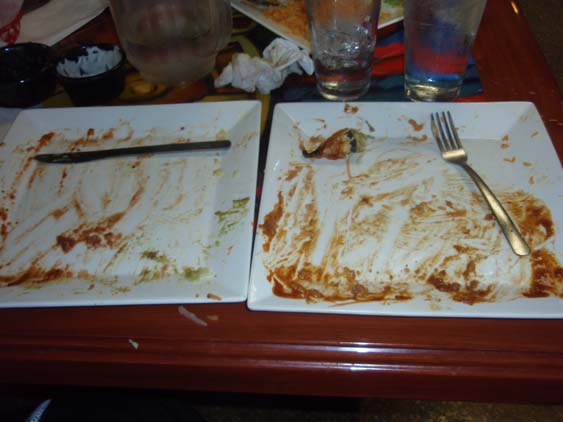 |
|
| |
The only problem
is they don't provide us wheelbarrows to wheel us to our rooms. But somehow
we manage to carefully waddle back there by ourselves. Needless to say,
with a feast like that stuffed down the pie hole, the skin over my stomach
pulls down the skin over my eyes and it's lights out in short order. |
|
| |
|
|
| |
|
|
| |
|
|
| |
|
|
| |
|
|
| |
|
|
| |
|
|
| |
|
|
| |
|
|
| |
|
|
| |
|
|
| |
|
|
| |
|
|
| |
|
|
| |
|
|
| |
|
|
| |
|
|
| |
|
|
| |
|
|
| |
|
|
| |
|
|
| |
|
|
| |
|
|
| |
|
|
| |
|
|
| |
|
|
| |
|
|
| |
|
|
| |
|
|
| |
|
|
| |
|
|
| |
|
|
| |
|
|
| |
|
|
| |
|
|
| |
|
|
| |
|
|
| |
|
|
| |
|
|
| |
|
|
| |
|
|
| |
|
|
| |
|
|
| |
|
|
























































